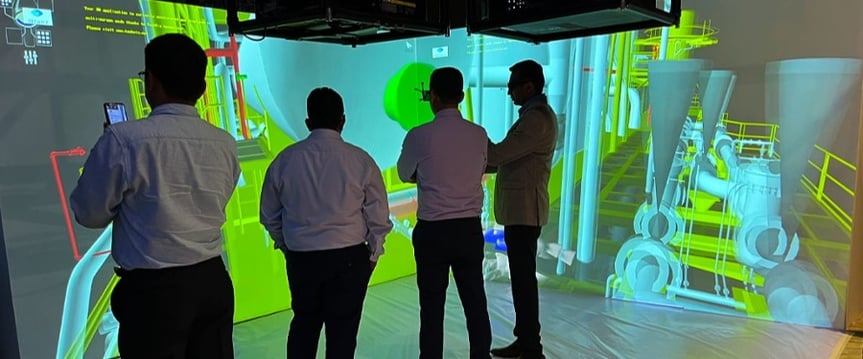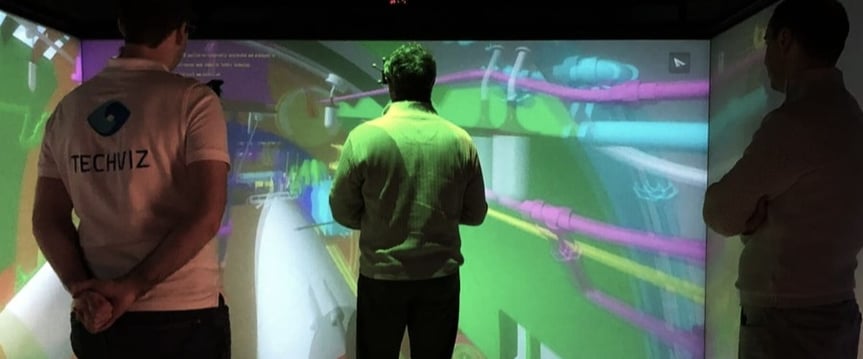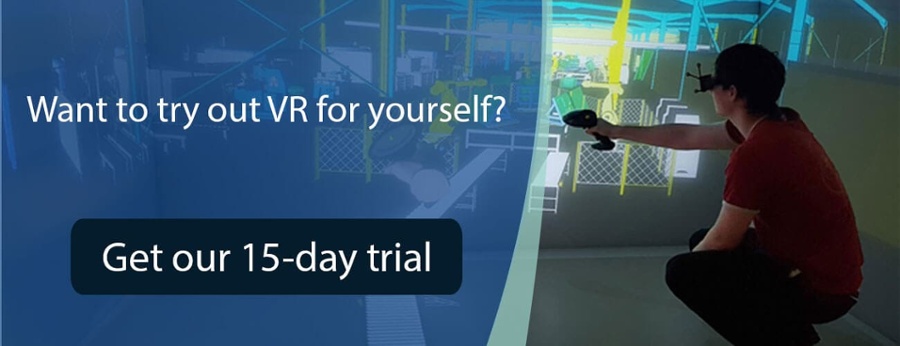.jpeg?width=863&height=360&name=Immersive-Room-at-Barcos-Connect-Mumbai-show-2022%20-%201200x900-1%20(1).jpeg)
Imagine a room where the lines between the virtual and the real is blurred. You just step inside this room with VR glasses on and walk around a new prototype before it’s even built! This is the reality of immersive rooms and VR CAVE. Both provide various industries with endless business applications from product design and prototyping to safety training and complex data analysis.
In this article, we will delve deeper into the world of immersive rooms, exploring their technical aspects, the difference with virtual reality headsets and how to setup an immersive room.
What is a Virtual Reality CAVE?
An immersive room is a physical space that immerses you in a virtual world thanks to a combination of high-end technologies. The combination of stereoscopic rear projection screens or LED walls with tracking devices create a realistic dimensional virtual environment that immerses the user in the virtual world.
What is the difference between an immersive room and a VR CAVE?
The word CAVE is an acronym that stands for Cave Automatic Virtual Environment. The first CAVE was developed by Carolina Cruz-Neira, Daniel J. Sandin, and Thomas A. DeFanti at the University of Illinois, Chicago Electronic Visualization Laboratory in 1992.
A VR Cave is a type of immersive room - generally a cube-shaped VR space of 3 m by 3 m-by 3 m contained within a larger room. It Is completely dark when in use to create a fully immersive experience. It is composed of a minimum of two “faces”, but it can go up to six sides with the ceiling, floor and four walls.
What are the different types of immersive rooms?
There are several types of Cave Automatic Virtual Environments (CAVEs) that are commonly used, each with their own unique characteristics and advantages. Here is a non-exhaustive list of VR caves that have been installed in various organizations and universities around the world.
2-Face CAVE
This vr CAVE forms a corner with two walls. It helps visualize 3D life-size image of objects and environments defined in CAD, thereby creating a virtual workspace. It’s the more affordable immersive room solution, however it can be limited in terms of immersion.

3-Face Standard CAVE
This vr CAVE forms a corner with two walls and a floor. It is more immersive than a two-sided CAVE, and it is great for companies that have a limited space but still wish to take advantage of the possibilities of 3D virtual reality.
3-Face Open CAVE
Instead of a cube-shaped immersive room, the three projection surfaces are angled at 135 degree and offers panoramic images with a wide field of view. It is an ideal solution for VR meetings, VR group sessions, three-dimensional simulation or wide-angle viewing.
4-Face CAVE
With more and more companies relying on VR; the 4-Face CAVE has somehow become a standard in the industry. It consists of 3 side screens and a floor screen and is designed to limit the rear projection space.
Cylindrical CAVE
It is a 270° cylindrical immersive virtual reality display that surrounds the viewer, and offers a more natural window to the virtual worlds than a standard cubic CAVE. The cylindrical CAVE overcomes the problem of distorted edges. The geometry allows multiple co-located VR users to simultaneously view data and share important decision-making tasks.
Transportable CAVE
This CAVE system from Barco is comprised of 2 sides with rear projection and one floor screen with front projection. The major components are built inside different flight cases with ladders and shelves are mounted inside.
If you need another option for a transportable VR session, you can try our solution Fly&Viz: an immersive room that fits in a suitcase.
CAVE2
CAVE2 was developed by the Electronic Visualization Laboratory (EVL) at the University of Illinois at Chicago (UIC). It is a hybrid VR system that mixes two visualization systems: the CAVE and the OptIPortal – a scalable-resolution display wall.
StarCAVE
StarCAVE was created by Cal IT facility in the University of California San Diego. It is a is a 5-wall plus floor projected VR room. It is an immersive room made for large-scale models that can accommodate up to 6 users at a time.
It's important to choose the right type of immersive room for your specific use case, taking into consideration factors such as space, budget, and the type of immersive experience you want to create. Do you need advice on a hardware or software standpoint? Our teams would be happy to give you pointers
Immersive room vs VR headsets: what is better for your use case?
There is no “best” alternative between head-mounted displays and immersive rooms. Both have pros and cons, but the ultimate choice depends on your specific use case of virtual reality. You can break this in different factors:
- The 3D CAD software: Creo, Catia, Navisworks… - and the size of your 3D model
- The number of users – and if they need to (all) be physically in the same place.
- If some users are working remotely: another alternative is to have an immersive room and a virtual reality headset working together
- The technical requirements such as the size of the screens (if relevant); the screen resolution, the field-of-view (FOV) the number of triangles…
- The degree of immersion needed for the use case – you might prefer a less immersive experience when working with other engineers on the same model
- The space requirements and the mobility of the VR installation: a standalone VR headset (such as the Oculus Quest 2 or Microsoft hololens 2) is more mobile than a tethered one (like a Varjo XR-3 or HTC Vive Focus 3) or a portable CAVE. Good luck moving an immersive room around.
- The tracking devices you want to add: full body tracking suit, hand-tracking, eye-tracking…
- How long and how often you will work in VR: an immersive room has less chances to cause motion-sickness than a VR headset.
- Etc.
By considering these factors, you can make a more informed decision on which technology is best suited for your specific use case.
How to set up an immersive room in your company?
Choosing the right type of immersive display
Have in mind what the size of your immersion room will be, as well as your use case. For instance, the larger the display surface will be, the more projectors of LED screens you will need to see large-scale 3D CAD models at scale 1:1 while maintaining high-fidelity.
Setting up an immersive room with rear projection
The images from the projector are diffused through the material from behind the screen. It’s a great solution if you want to avoid users or objects to cast shadows in the VR space. However, you will need to choose an appropriate substrate: fabric screens, glass, rigid or semi-rigid acrylics).
Setting up an immersive room with front projection
The images from the projector are reflected into the surface of the screen. It is a cost-effective solution compared to the other options. However, there are more risks to cast shadows in the immersive room with this method, and there might be some reflection issues.
Setting up an immersive room with LED display technology
The LED screen directly broadcasts the 3D model. This option generally requires lower maintenance and less facility space requirement than regular projection-based VR environments.
Setting up an immersive room with LCD video walls
LCD video walls also display the images directly, with generally a higher light output than LED-lit projection cubes, which allows to use them in most lighting conditions.

Checking VR PC requirements
Desktop-based Virtual Reality technology requires extremely high-performance computer hardware – or remote computing thanks to cloud VR – to offer enough frame rate for a comfortable experience. Here are our recommended requirements for a VR-ready PC :
- Graphic card for VR: NVIDIA GTX 1060 / AMD Radeon RX 480 or greater
- CPU: Intel i5-4590 / AMD FX 8350 equivalent or greater
- Memory: 8GB RAM or greater
- Video Output: Compatible HDMI 1.3 video output / DisplayPort 1.2
- USB Ports: from 1 to 4 USB 3.0 port
- OS: Windows 10
For more information on the subject, consider using SteamVR performance test tool. The test measures your system’s rendering power and determines whether your system is capable of running VR content at 90fps and whether VR content can tune the visual fidelity up to the recommended level.
Using the right visualization software
To ensure the best VR experience inside the immersive room, it is crucial to choose the right visualization software. The software must be compatible with both your CAD application, immersive display and VR devices. Additionally, the software's rendering performance must provide a smooth visual experience for the viewer, without any stuttering, whether in 2D or 3D stereo depth.
TechViz software is a universal VR solution tailored for engineering that allows you to visualize your 3D data in VR, directly from more than 200 compatible applications (Catia, Creo, NX, Navisworks and many more) and is fully compatible with all immersive rooms.






 Back to Blog
Back to Blog





